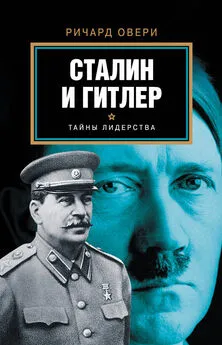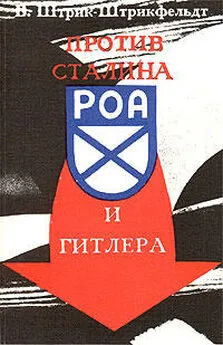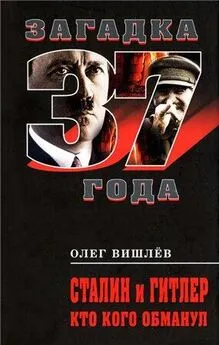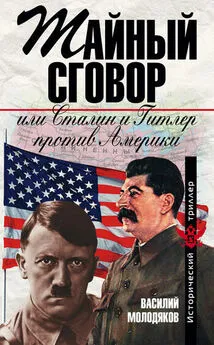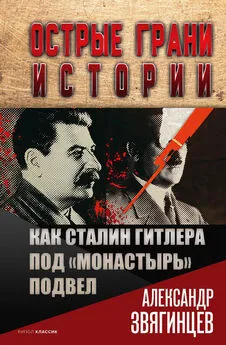Ричард Овери - Сталин и Гитлер
- Название:Сталин и Гитлер
- Автор:
- Жанр:
- Издательство:АСТ
- Год:2015
- Город:Москва
- ISBN:978-5-17-082961-3
- Рейтинг:
- Избранное:Добавить в избранное
-
Отзывы:
-
Ваша оценка:
Ричард Овери - Сталин и Гитлер краткое содержание
Что это были за личности?
Какими были методы их правления?
В чем мораль диктатуры как таковой и к чему она ведет?
На эти и другие наболевшие вопросы отвечает известный британский историк, автор крупных работ по истории Второй мировой войны Ричард Овери.
При сравнение и сопоставление двух режимов Овери рассматривает степень и характер народной поддержки, очаги противостояния и сопротивления, путь к власти каждого из диктаторов и процесс формирования культа личности и т. д.
Сталин и Гитлер - читать онлайн бесплатно полную версию (весь текст целиком)
Интервал:
Закладка:
37. E. Bacon The Gulag at War: Stalin’s Forced Labour System in the Light of the Archives (London, 1994), pp. 73–6; Ivanova, Labor Camp Socialism, pp. 82–5 for full details of GUlag camp economic organization and output before 1941.
38. Bacon, Gulag at War, pp. 139–44; Ivanova, Labor Camp Socialism, pp. 94–5.
39. Pohl, Stalinist Penal System, p. 16.
40. Bacon, Gulag at War, pp. 142–3.
41. Pohl, Stalinist Penal System, p. 17.
42. Stettner, ‘Archipel GULag’, pp. 181, 205–6.
43. Stettner, ‘Archipel GULag’, pp. 203–4; Pohl, Stalinist Penal System, pp. 50–52.
44. Pohl, Stalinist Penal System, pp. 17–18; Ivanova, Labor Camp Socialism, pp. 65–7.
45. Sofsky, Order of Terror, pp. 35–6; D. A. Hackett (ed.) The Buchenwald Report (Boulder, Colo., 1995), pp. 112–13.
46. Pingel, Häftlinge unter SS-Herrschaft, p. 230.
47. Kaienberg, ‘Vernichtung durch Arbeit, p. 60.
48. Kirstein, Konzentrationslager Natzweiler, p. 65; K. Orth ‘Gab es eine Lagergesellschaft? “Kriminelle” und politische Häftlinge im Konzentrationslager’, in N. Frei, S. Steinbacher and B. Wagner (eds) Ausbeutung, Vernichtung, Öffentlichkeit: neue Studien zur nationalsozialistischen Lagerpolitik (Munich, 2000), p. 119.
49. Pohl, Stalinist Penal System, pp. 35–7; Bacon, Gulag at War, p. 153. In 1944 60.9 per cent were Russians, 11.1 per cent Ukrainians.
50. Pohl, Stalinist Penal System, p. 22; J. A. Getty, G. T. Rittersporn and V. N. Zemskov ‘Victims of the Soviet Penal System in the Pre-war Years: A First Approach on the Basis of the Archival Evidence’, American Historical Review, 98 (1993), p. 1031–3; N. Werth and G. Moullec (eds) Rapports secrets sovietiques: La societe russe dans les documents confi dentiels 1921–1991 (Paris, 1994), p. 386, Report of the chief of the GUlag on the work of the GUlag during the Great Patriotic War, 10 March 1945, which gives fi gures for ‘counter-revolutionaries’ and common criminals, 1941–45.
51. Pohl, Stalinist Penal System, p. 25.
52. C. Füllberg-Stolberg, M. Jung, R. Riebe and M. Scheitenberger (eds) Frauen in Konzentrationslagern Bergen-Beisen, Ravensbrück (Bremen, 1994), p. 79. On the proportion of ‘asocials’ see Orth, Das System der Konzentrationslager, pp. 51–3. In the late 1930s this proportion was high: 58 per cent at Sachsenhausen in 1938.
53. Pohl, Stalinist Penal System, pp. 30–31; Stettner, ‘Archipel GULag’, pp. 202–3; On Akmolinsk camp, V. Shapovalov (ed.), Remembering the Darkness: Women in Soviet Prisons (Lanham, Md, 2001), p. 207.
54. J. Morrison Ravensbrück: Everyday Life in a Woman’s Concentration Camp (London, 2000), pp. 27–9, 86.
55. Kaienberg, ‘KZ-Haft und Wirtschaftsinteresse’, p. 51.
56. Pohl, Stalinist Penal System, pp. 32–3; Schwarz, nationalsozialistischen Lager, pp. 84–6; Werth and Moullec, Rapports secrets, p. 387.
57. Shapovalov, Remembering the Darkness, p. 206.
58. M. Nahon Birkenau: Camp of Death (Tuscaloosa, Ala., 1989), pp. 37–9.
59. Morrison, Ravensbriick, pp. 33–4.
60. Parvilahti, Beria’s Gardens, pp. 93–7.
61. Pingel, Häftlinge unter SS-Herrschaft, p. 135.
62. Dwork and van Pelt, Auschwitz, pp. 263–4.
63. M. T. Allen The Banality of Evil Reconsidered: SS Mid-level Managers of Extermination Through Work’, Central European History, 30 (1997), p. 263; see too A. Beyerchen ‘Rational Means and Irrational Ends: Thoughts on the Technology of Racism in the Third Reich’, Central European History, 30 (1997), pp. 386–402.
64. Parvilahti, Berief s Gardens, p. 95; D. Dallin and B. Nicolaevsky Forced Labor in Soviet Russia (London, 1947), pp. 13–14.
65. Pohl, Stalinist Penal System, pp. 15–17.
66. Parvilahti, Bend’s Gardens, p. 126.
67. Pingel, Häftlinge unter SS-Herrschaft, pp. 164–5.
68. Nahon, Birkenau: Camp of Death, p. 53.
69. Dallin and Nicolaevsky, Forced Labor, pp. 6–7; Parvilahti, Berits Gardens, p. 98.
70. P. Barton U institution concentrationnaire en Russe 1930–1957 (Paris, 1959), p. 80; on norm competition in the camps see L. von Koerber Sowjetrussland kämpft gegen das Verbrechen (Berlin, 1933), pp. 24–5.
71. Dwork and van Pelt, Auschwitz, pp. 194–6; P. Steinberg Speak You Also: a Survivor’s Reckoning (London, 2001), pp. 66–71.
72. A. Solzhenitsyn One Day in the Life of Ivan Denisovich (London, 1963), p. 143.
73. Sofsky, Order of Terror, p. 118; Nohan, Birkenau: Camp of Death, p. 39.
74. Pingel, Häftlinge unter SS-Herrschaft, pp. 114–16.
75. Parvilahti, Beria’s Gardens, pp. 109, 125.
76. See for example K. Dunin-Wasowicz Resistance in the Concentration Camps (Warsaw, 1982).
77. Morrison, Ravensbriick, pp. 130–33.
78. Pohl, Stalinist Penal System, p. 31.
79. Morrison, Ravensbriick, p. 365; J. Bardach and K. Gleeson Man is Wolf to Man: Surviving the Gulag (Berkeley, Calif., 1998) pp. 191–3.
80. Steinberg, Speak You Also, p. 72.
81. Bardach and Gleeson, Man is Wolf to Man, pp. 227–8.
82. For example Parvilahti, Beria’s Gardens, pp. 118, 125; see too, Pingel, Häftlinge unter SS-Herrschaft, p. 135.
83. Dallin and Nicolaevsky, Forced Labor, p. 6.
84. Bardach and Gleeson, Man is Wolf to Man, pp. 247–9.
85. Y. Shymko (ed.) For This Was I Born (Toronto, 1973), p. 41; D. Panin The Notebooks ofSologdin (New York, 1976).
86. Steinberg, Speak You Also, p. 77.
87. Morrison, Ravensbrück, pp. 289–91.
88. Parvilahti, Bend’s Gardens, pp. 99–100; Bardach and Gleeson, Man is Wolf to Man, p. 236.
89. Pohl, Stalinist Penal System, pp. 14–16; B. Perz Projekt Quarz: Steyr-Daimler-Puch und das Konzentrationslager Melk (Vienna, 1991), p. 300; Parvilahti, Beria’s Gardens, pp. 132–3.
90. Steinberg, Speak You Also, p. 22.
91. Barton, Vinstitution concentrationnaire, pp. 78–9; Bardach and Gleeson, Man is Wolf to Man, p. 213.
92. L. Crome Unbroken: Resistance and Survival in the Concentration Camps (London, 1988), pp. 54, 56–7; see too Kaienberg, ‘Vernichtung durch Arbeit’, p. 56.
93. Werth and Moullec, Rapports secrets, pp. 377–82: Report from N. Ezhov, March 1938 ‘on the state of a number of labour camps’; Report of the GUlag operational department, 17 May 1941 on the camp at Sredne-Belsk; Report of deputy chief of GUlag operational department, 23 October 1941 on rising mortality at Aktiubinsk.
94. Crome, Unbroken: Resistance and Survival, p. 62.
95. U. Herbert Best: Biographische Studien über Radikalismus, Weltanschauung und Vernunft 1903–1989 (Bonn, 1996), p. 151; Tuchel, ‘Dimensionen des Terrors’, p. 381.
96. Sofsky, Order of Terror, p. 16.
97. I. Müller Hitler’s Justice: the Courts of the Third Reich (London, 1991), p. 56.
98. M. Kárný ‘Das SS-Wirtschafts-Verwaltungshauptamt’, in Hamburger Stiftung zur Förderung von Wissenschaft und Kultur (ed.) ‘Deutsche Wirtschaft’: Zwangsarbeit Von KZ-Häftlingen für Industrie und Behörden (Hamburg, 1991) pp. 160–64; F. Piper ‘Industrieunternehmen als Initiatoren des Einsatzes von KZ-Häftlingen’, in Hamburger Stiftung, ‘Deutsche Wirtschaft’, pp. 97–103. Out of 500,000 workers approximately 230–250,000 worked in private sector fi rms.
99. Herbert, Best, pp. 169–70.
100. Barton, L’institution concentrationnaire, p. 56; Shapovalov, Remembering the Darkness, p. 207.
101. P. Levi The Drowned and the Saved (London, 1988), p. 100.
Заключение
1. P. Sorokin The Sociology of Revolution (New York, 1967) pp. 185–6.
2. V. M. Berezhkov At Stalin’s Side (New York, 1994), pp. 7, 72.
3. Berezhkov, At Stalin’s Side, p. 7.
4. See for example L. Dupeux Strategie communiste et dynamique conservatrice: essai sur les differents sens de Vexpression ‘National-Bolchevisme’ (Paris, 1976).
5. T. Todorov Hope and Memory: Refl ections on the Twentieth Century (London, 2003), p. 25 ff.
6. E. H. Vieler The Ideological Roots of German National Socialism (New York, 1999), p. 125; see also D. Gasman The Scientifi c Origins of National Socialism (London, 1971), pp. 147–65.
7. ‘The International Character of the October Revolution’ in J. Stalin Problems of Leninism (Moscow, 1947), pp. 198–203.
8. A. Ulam Expansion and Co-Existence: a History of Soviet Foreign Policy 1917–1967 (London, 1968) p. 78.
9. H. Mehringer Die NSDAP als politische Ausleseorganisation (Munich, 1938), p. 5.
10. W. Treue ‘Hitlers Denkschrift zum Vierjahresplan 1936’, Vierteljahreshefte für Zeitgeschichte, 3 (1955), p. 201.
11. ‘Der Schlussrede des Führers auf dem Parteikongress 1934’ in G. Neesse Die Nationalsozialistische Deutsche Arbeiterpartei (Stuttgart, 1935), p. 195.
12. Treue, ‘Denkschrift’, p. 202.
13. For details on the Gestapo’s Jewish offi ces see H. Berschel Bürokratie und Terror: Das Judenreferat der Gestapo Düsseldorf 1935–1945 (Essen, 2001).
14. H. Rauschning Hitler Speaks (London, 1939), p. 257.
15. P. Reidel ‘Aspekte ästhetischer Politik im NS-Staat’ in U. Hermann and U. Nassen (eds.) Formative Ästhetik im Nationalsozialismus. Intentionen, Medien und Praxisformen totalitärer ästhetischer Herrschaft und Beherrschung (Weinheim, 1994), p. 14.
16. G. C. Guins Soviet Law and Soviet Society (The Hague, 1954), p. 30. In a teacher’s manual from 1940 schoolchildren were to be instructed ‘to hate their country’s enemies’. See D. Brandenberger National Bolshevism: Stalinist Mass Culture and the Formation of Modern Russian National Identity 1931–1956 (Cambridge, Mass., 2002), p. 65.
17. See in general J. Stalin On the Opposition (Peking ed., 1974), speeches and articles from the 1920s on problems of party unity and party disagreements.
18. E. van Ree ‘Stalin’s Organic Theory of the Party’, Russian Review, 52 (1993), p. 52.
19. P. Stachura Gregor Strasser and the Rise of Nazism (London, 1983), p. 75.
20. Neesse, Nationalsozialistische Partei, p. 10.
21. See for example the discussion in I. Gutkin The Magic of Words: Symbolism, Futurism, Socialist Realism’ in B. G. Rosenthal The Occult in Russian and Soviet Culture (Ithaca, NY, 1997), pp. 241–4.
22. G. Alexopoulos Stalirfs Outcasts: Aliens, Citizens, and the Soviet State 1926–1936 (Ithaca, NY, 2002) esp. ch. 2.
23. T. Alkemeyer and A. Richantz ‘Inszenierte Körperträume: Reartikulation von Herrschaft und Selbstbeherrschung in Körperbildung des Faschismus’ in Hermann and Nassen, Formative Ästhetik, pp. 82–3.
24. See for example S. Plaggenborg ‘Gewalt und Militanz im Sowjetrussland 1919–1930’, Jahrbücher für die Geschichte Osteuropas, 44 (1996), pp. 409–30.
25. M. Pabst Staatsterrorismus: Theorie und Praxis kommunistischer Herrschaft (Graz, 1997), p. 15.
26. Stalin, Works, vol. 6, p. 121.
27. G. A. Wetter Dialectical Materialism: a Historical and Systematic Survey of Philosophy in the Soviet Union (New York, 1958), pp. 221–2.
28. F. Kroll Utopie als Ideologie: Geschichtsdenken und politisches Handeln im Dritten Reich (Paderborn, 1998), pp. 56–64, 84–8.
29. Uncensored Germany: Letters and News Sent Secretly from Germany to the German Freedom Party (London, 1940), p. 80, ‘Letter from a Tradesman’, September 1939.
30. A. Resis (ed.) Molotov Remembers: Inside Kremlin Politics (Chicago, 1993), p. 264, interview 12 April 1973.
31. A. Gide Back from the U.S.S.R. (London, 1937), pp. 45, 48.
32. Gide, Back from the U.S.S.R., p. 45.
33. M. Heller Cogs in the Soviet Wheel: the Formation of Soviet Man (London, 1988), p. 287; see also the discussion on language in E. Naiman ‘Introduction’ to A. Platanov Happy Moscow (London, 2001), pp. xxxi – xxxvii.
Читать дальшеИнтервал:
Закладка:
